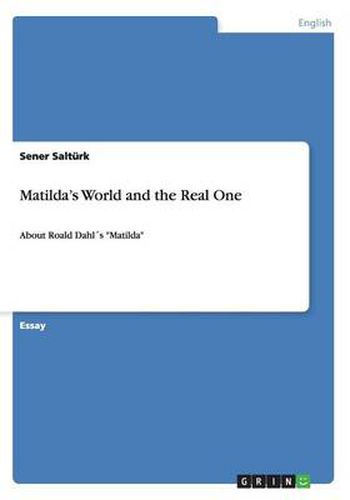Readings Newsletter
Become a Readings Member to make your shopping experience even easier.
Sign in or sign up for free!
You’re not far away from qualifying for FREE standard shipping within Australia
You’ve qualified for FREE standard shipping within Australia
The cart is loading…






Essay from the year 2005 in the subject English Language and Literature Studies - Literature, grade: 1,0, University of Dortmund (Anglistisches Institut), language: English, abstract: […] Though children’s books not infrequently take on the subject of children suffering under their own weaknesses, the major difference between the world in these books and the real world is that in the latter they cannot define the rules, nor can they rule. In a fictional world, however, they can become heroes and masters of their own fate, or even, anything and anyone. Here children can become free in an existential sense of the word. In order to reach this freedom the child must cope with a number of different and quite difficult and dangerous tasks. But what sort of world is it actually? An aforementioned ersatz world, a parallel world or just a copy of the real world they are desperately striving to escape from? In any case, this fictitious worlds do not only include the things in it but quite frequently (comp. above mentioned Harry Potter, Huck Finn etc.), focus strongly on their protagonists, a fictional child that is in many ways like any other child save in one thing: he or she is capable of ‘doing things’ the others cannot, thus being enabled to change the status quo of things (or of the world). This status quo, i.e. conflicts children generally encounter, is depicted in ironic, quite often exaggerated ways that the child heroes have to face and overcome. Of course, in order to accomplish this, it takes an extraordinary child and it is no coincidence that many a ‘successful’ children’s book either carries its protagonist(s)‘s name in the title or is actually named after them. As is Roald Dahl’s Matilda. As for the world Matilda lives in, it contains many elements of different genres (such as fairy tales etc.) that I will pay my closer attention to, hoping to yield some information on what these worlds include and what makes them so attractive to children and approach to t
$9.00 standard shipping within Australia
FREE standard shipping within Australia for orders over $100.00
Express & International shipping calculated at checkout
Stock availability can be subject to change without notice. We recommend calling the shop or contacting our online team to check availability of low stock items. Please see our Shopping Online page for more details.
Essay from the year 2005 in the subject English Language and Literature Studies - Literature, grade: 1,0, University of Dortmund (Anglistisches Institut), language: English, abstract: […] Though children’s books not infrequently take on the subject of children suffering under their own weaknesses, the major difference between the world in these books and the real world is that in the latter they cannot define the rules, nor can they rule. In a fictional world, however, they can become heroes and masters of their own fate, or even, anything and anyone. Here children can become free in an existential sense of the word. In order to reach this freedom the child must cope with a number of different and quite difficult and dangerous tasks. But what sort of world is it actually? An aforementioned ersatz world, a parallel world or just a copy of the real world they are desperately striving to escape from? In any case, this fictitious worlds do not only include the things in it but quite frequently (comp. above mentioned Harry Potter, Huck Finn etc.), focus strongly on their protagonists, a fictional child that is in many ways like any other child save in one thing: he or she is capable of ‘doing things’ the others cannot, thus being enabled to change the status quo of things (or of the world). This status quo, i.e. conflicts children generally encounter, is depicted in ironic, quite often exaggerated ways that the child heroes have to face and overcome. Of course, in order to accomplish this, it takes an extraordinary child and it is no coincidence that many a ‘successful’ children’s book either carries its protagonist(s)‘s name in the title or is actually named after them. As is Roald Dahl’s Matilda. As for the world Matilda lives in, it contains many elements of different genres (such as fairy tales etc.) that I will pay my closer attention to, hoping to yield some information on what these worlds include and what makes them so attractive to children and approach to t